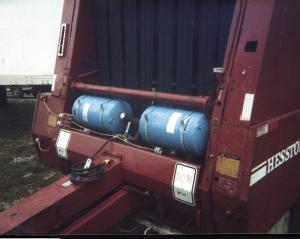2002 - Volume #26, Issue #5, Page #20
[ Sample Stories From This Issue | List of All Stories In This Issue | Print this story
| Read this issue]
On-Board System Puts Out Fires
 |
And when Lohman, a farmer and plumber from near Hillsboro, Ill., went out and bought a new Hesston baler, the first thing he did was to equip it with an identical system.
He got the idea originally because the Vermeer baler had been through a fire before he bought it.
He used a couple of water pressure tanks as the basis for his on-board fire fighting system. The tanks mount in an open area above the hitch where they wouldn't interfere with the baler's operation. He plumbed the tanks together using 3/4-in. steel pipe from their water inlets. These short pipes screw into a T, which allows water from both tanks to feed down to a lever-operated boiler drain valve. Another short length of pipe to from the boiler drain has a ball valve at the end. There he attaches his fire-fighting hose, a 10-ft. length of 3/4-in. pressure washer hose. He also pumps water into the tanks through this valve.
In the line between the tanks, he installed a pressure gauge with a dial large enough that he could see it from the tractor. This lets him know how much pressure is left in the event he's using the water, and also alerts him should there be a leak or partially open valve.
"I put in the boiler drain valve in as a backup, in case the ball valve should happen to leak," he says.
At the business end of his 10-ft. fire-fighting hose, he attached a plastic ball valve that turns on and off easily and quickly, and on that is a small brass hose nozzle that, he says, "Ówill spray straight and pretty far."
He fills the tanks with water to 60 psi, which gives him ample water pressure and quantity to fight the fires he's had to date. And he's had a couple.
The first one happened when a tree root got caught in a roller. By the time he saw the smoke, the root and roller were both scorched. "I put it out and had plenty of water left over," he says. "The root had burned to fit the curve on the roller and wouldn't come back out. I had to unbolt the roller to move it aside before the root could be pulled out."
The second time he used his fire extinguishing system, a bearing burned out and caught chaff on fire. The chaff fell to the ground and caught the field on fire behind the baler. "I put out the field first, then the chaff on the baler and then cooled the bearing. After that, I dumped the bale and checked for more fire," he says.
Lohman says you could use any size pressure tanks, but the bigger, the better. "You could go with just one big tank, but two smaller ones were less expensive and it makes more sense to me. There's little chance of both air bladders failing at the same time," he says. "It doesn't matter where you locate the tanks, either, as long as you T them together and the valve and hose are located where you can get to them in a hurry."
He says there are other uses for the system, like washing chaff and dirt off the tractor cab windows, or cleaning your hands after completing maintenance or repairs on the baler. "You could put on a longer hose, but so far, 10 ft. has been long enough for me," he says.
Lohman says winterizing the system is easy. "You just open the valves and straighten the hose and all the water drains out," he says.
Contact: FARM SHOW Followup, Jim Lohman, 14142 Seven Sisters Ave., Hillsboro, Ill. 62049

Click here to download page story appeared in.

Click here to read entire issue
To read the rest of this story, download this issue below or click here to register with your account number.




